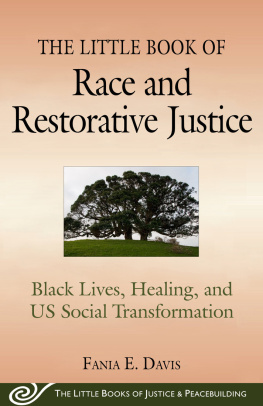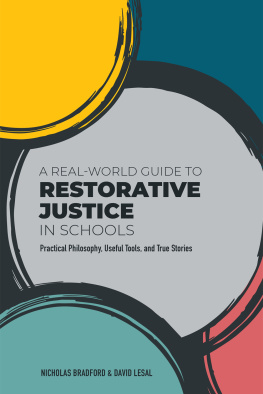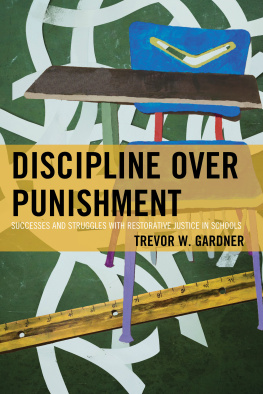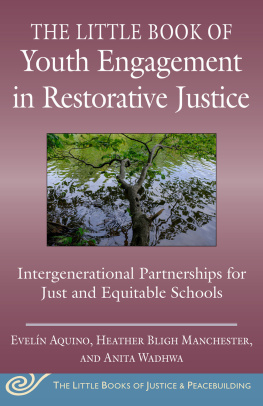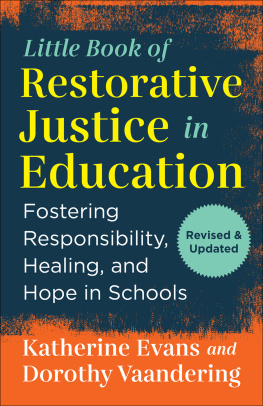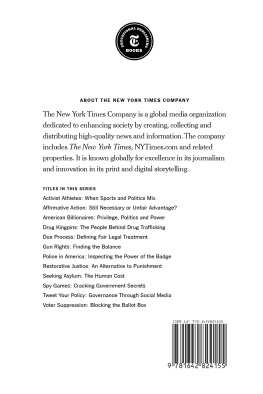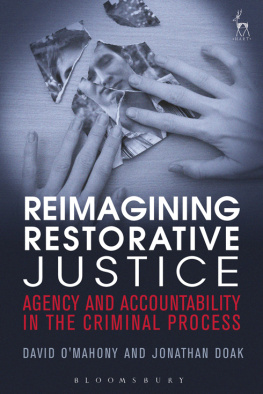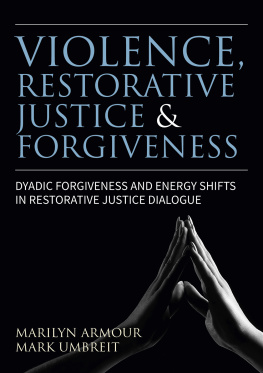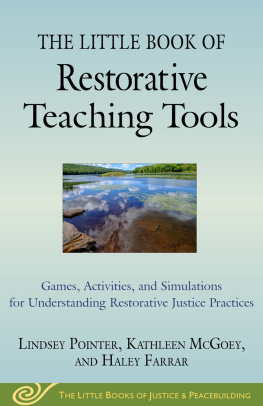


Published titles include:
The Little Book of Restorative Justice: Revised & Updated , by Howard Zehr
The Little Book of Conflict Transformation , by John Paul Lederach
The Little Book of Family Group Conferences, New Zealand Style , by Allan MacRae and Howard Zehr
The Little Book of Strategic Peacebuilding , by Lisa Schirch
The Little Book of Strategic Negotiation , by Jayne Seminare Docherty
The Little Book of Circle Processes , by Kay Pranis
The Little Book of Contemplative Photography , by Howard Zehr
The Little Book of Restorative Discipline for Schools , by Lorraine Stutzman Amstutz and Judy H. Mullet
The Little Book of Trauma Healing , by Carolyn Yoder
The Little Book of Biblical Justice , by Chris Marshall
The Little Book of Restorative Justice for People in Prison , by Barb Toews
The Little Book of Cool Tools for Hot Topics , by Ron Kraybill and Evelyn Wright
El Pequeo Libro de Justicia Restaurativa , by Howard Zehr
The Little Book of Dialogue for Difficult Subjects , by Lisa Schirch and David Campt
The Little Book of Victim Offender Conferencing , by Lorraine Stutzman Amstutz
The Little Book of Restorative Justice for Colleges and Universities , by David R. Karp
The Little Book of Restorative Justice for Sexual Abuse , by Judah Oudshoorn with Michelle Jackett and Lorraine Stutzman Amstutz
The Big Book of Restorative Justice: Four Classic Justice & Peacebuilding Books in One Volume , by Howard Zehr, Lorraine Stutzman Amstutz, Allan MacRae, and Kay Pranis
The Little Book of Transformative Community Conferencing , by David Anderson Hooker
The Little Book of Restorative Justice in Education , by Katherine Evans and Dorothy Vaandering
The Little Book of Restorative Justice for Older Adults , by Julie Friesen and Wendy Meek
The Little Book of Racial Healing , by Thomas Norman DeWolf and Jodie Geddes
The Little Books of Justice & Peacebuilding present, in highly accessible form, key concepts and practices from the fields of restorative justice, conflict transformation, and peacebuilding. Written by leaders in these fields, they are designed for practitioners, students, and anyone interested in justice, peace, and conflict resolution.
The Little Books of Justice & Peacebuilding series is a cooperative effort between the Center for Justice and Peacebuilding of Eastern Mennonite University and publisher Good Books.

Copyright 2019 by Fania E. Davis
All rights reserved. No part of this book may be reproduced in any manner without the express written consent of the publisher, except in the case of brief excerpts win critical reviews or articles. All inquiries should be addressed to Good Books, 307 West 36th Street, 11th Floor, New York, NY 10018.
Good Books books may be purchased in bulk at special discounts for sales promotion, corporate gifts, fund-raising, or educational purposes. Special editions can also be created to specifications. For details, contact the Special Sales Department, Good Books, 307 West 36th Street, 11th Floor, New York, NY 10018 or .
Good Books is an imprint of Skyhorse Publishing, Inc., a Delaware corporation.
Visit our website at www.goodbooks.com
10 9 8 7 6 5 4 3 2 1
Library of Congress Cataloging-in-Publication Data
Names: Davis, Fania, author.
Title: The little book of race and restorative justice: black lives, healing, and US social transformation / Fania Davis.
Description: New York NY: Good Books, 2019. | Series: Little books of justice and peacebuilding
Identifiers: LCCN 2018057655 (print) | LCCN 2018060299 (ebook) | ISBN 9781680993448 (eBook) | ISBN 9781680993431 (paperback)
Subjects: LCSH: Restorative justiceUnited States. | African AmericansSocial conditions1975- | African Americans Legal status, laws, etc. | BISAC: LAW / General. | SOCIAL SCIENCE / Minority Studies. | LAW / Civil Rights.
Classification: LCC HV8688 (ebook) | LCC HV8688 .D38 2019 (print) | DDC 305.896/073dc23
LC record available at https://lccn.loc.gov/2018057655
Series editor: Barbara Toews
Cover photograph: Howard Zehr
Paperback ISBN: 978-1-68099-343-1
eBook ISBN: 978-1-68099-344-8
Printed in Canada
Table of Contents
The Journey to Racial Justice and Restorative Justice

AKOBEN
Akoben is a traditional wind instrument used to summon warriors to the battlefield. May we be alert, devoted, and prepared to serve a good cause.
T he field of restorative justice arose in the mid-1970s in the United States out of disaffection with the dysfunction of our prevailing justice system, in an effort to transform the way we think about and do justice. This was a new but old justice dawning on the stage of human history. During its first forty years, however, the restorative justice (RJ) community largely failed to address race, quite surprisingly given that it is people of color who overwhelmingly bear the brunt of the horrific inequities of our nations criminal justice system, past and present. Just as the restorative justice community has historically failed to adopt a racial or social justice stance, few racial justice activists embrace restorative justice. Calling for a convergence of the two, this Little Book of Race and Restorative Justice urges racial justice advocates to invite more healing energies into their lives and restorative justice advocates to bring more warrior energies into theirs.
My intent in invoking healer and warrior archetypes warrants clarification. I do not use warrior in its oppositional or militaristic sense, but in its spiritual valence, connoting the integration of power and compassion, as embodied in the bodhisattva, or warrior-sage. The fierce African Maasai warriors, whose foremost concern is with the well-being of the children, also come to mind. In an example closer to home, I think of the indigenous youth activists at Standing Rock who led the historic resistance to the Dakota Access Pipeline installation in 2016 and who engaged in ceremony as a form of social action, proclaiming they were water and earth protectors, not simply protestors.
Nor do I use the term healer to connote one who works to heal the human body. Rather, I use it more broadly to mean one who aspires to heal the social body, or transform social harm. Our nation was born in the horrific traumas of genocide and slavery. Because we have neither fully acknowledged nor reckoned with these twin traumas, much less worked to heal them, they perpetually reenact themselves transgenerationally. We who dedicate our lives to social change have a chance to succeed only if we also devote ourselves to individual and collective healing.
Restorative justice and the indigenous ethos in which it is grounded (fully discussed in ) are strongly relational in their orientation. Both deeply value entering into and maintaining right relationship as well as sharing ones personal story. Indigenous protocol invites us to introduce ourselves through ancestors, lineage, and land. And so I open this book by introducing myself and recounting how I came to embrace both racial justice and restorative justice, following the way of the warrior and healer.
Next page
